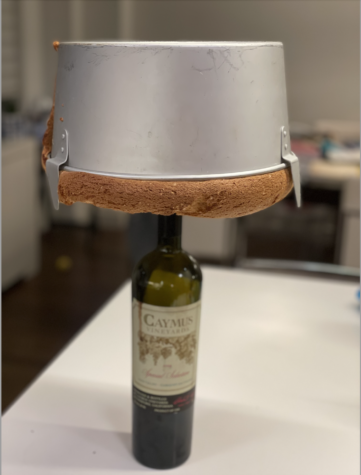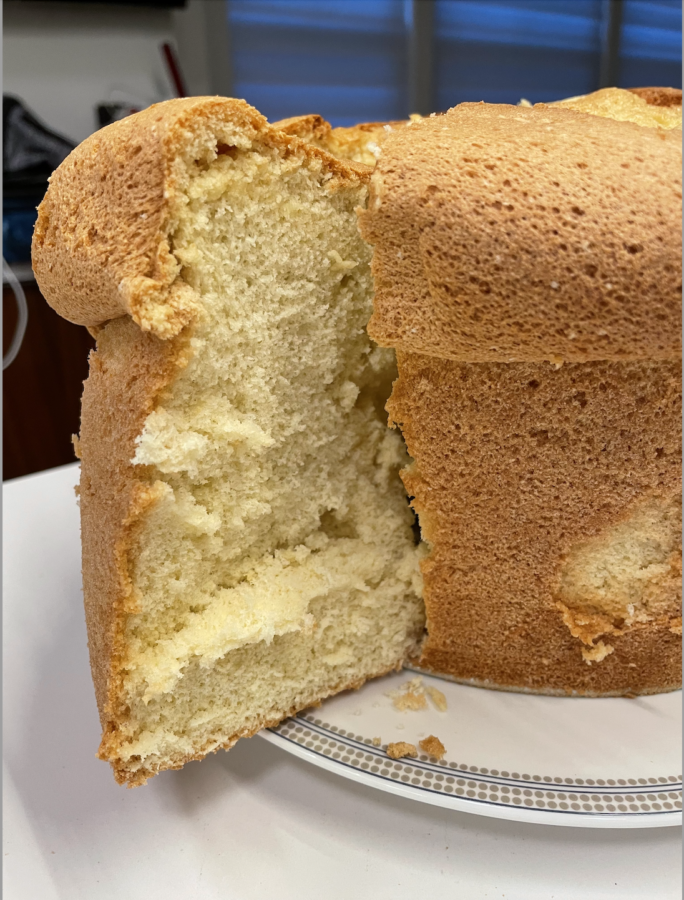European Sponge Cake: A Recipe and My Family’s History With Making It
My family’s tradition of making European sponge cake has been passed down through three generations, but only recently have we rediscovered the delicious and unique family recipe.
Here is the finished sponge cake that my family often bakes. With its light, airy texture and delicious taste, it has become a staple dessert for my family.
Upon waking up late on a Sunday morning, the familiar aroma of a sweet baked good dominates my senses. As I make my way into the kitchen, I watch my sister and mother carefully maneuver to balance an upside down cake tin with fluffy cake puffing out of the top on a wine bottle. It is a strategic yet worthwhile process to ensure that the structure will not topple over and erase the hard work put into making the cake. This is one of the final steps performed to make my family’s European Sponge Cake.
Now, you may be asking where the bottle and cake tin come into play, and while it prompts confusion, this is how to assure that the light, airy sponge cake will rise as much as possible. A step devised by my relatives, it made the ritual cake baking into a desire to have the highest, most fluffy cake.
My family lineage descends from Central Europe, and this recipe for “twelve egg,” or European, sponge cake, was first made by my mom’s family (her father and his siblings, most notably my aunt Sarah), who came to America after the end of World War II.
Beloved by all, my great aunt Sarah’s sponge cake became a staple food for my family, as it was the perfect sweet, filling, comforting item that was made with care and authenticity. My mother says that while there was no physical recipe passed down, the act of concocting the sponge cake was performed by her and her mother. However, it was my sister who wanted to recreate this delicacy that we had spent so many years hearing about, yet could not find a recipe for.
At my grandmother’s suggestion, we researched a recipe for a “12 egg sponge cake,” the whopping 12 eggs used being a hallmark of the elaborate recipe. Soon enough, we located a generic, but nonetheless, accurate recipe for the sponge cake that my grandfather’s family had often indulged in.
After my mother and sister began making the cake, they realized there were modifications to be made to perfect the nostalgic recipe. My mother said of the original recipe, “It was too sweet, so I always add less sugar than the recipe calls for. I remembered the 12 eggs, and I remembered that my mother used to put orange juice in it, but we have started putting in lemon juice.” All of these little fixes worked to form an exact copy of the original sponge cake.
Here is the recipe that we use today:
12 egg yolks
3 c. sugar
1/2 c. cold water
+3 tablespoons either lemon juice or OJ
1 tbsp. vanilla
3 c. sifted flour
12 egg whites
2 1/4 tsp. baking powder
Beat egg yolks for about 5 minutes. Add sugar and beat for about 3 minutes. Add water, juice, vanilla and flour and beat for 5 minutes.
Make sure yolks and whites are separated well
Beat egg whites with baking powder until soft peaks form, then fold into batter. Pour into 12-inch pan and bake for 1 hour at 350 degrees. The cake will likely rise above the edges of the pan.
Turn upside down and balance on a bottle!

While this recipe seems easy enough to follow, its intricacies are most vital to its success. For instance, one of the most important and overlooked parts is making sure the egg whites are properly separated from the yolks. Only the whites are used in this recipe, and if even a drop of egg yolk gets in, it can destroy the entire texture and appearance of the cake.
Another seemingly strange part of the recipe is the act of balancing it upside down on top of a bottle; this is done once the cake is removed from the oven in order to maintain how much the cake has risen. Although the pan has parts attached to the top for the user to balance the cake upside down on, it is custom when my family and I bake the sponge cake to use the bottle just to make sure the cake rises as much as possible.
Making the sponge cake is one of my favorite activities to do with my family because of how many years of tradition it carries and how much it ties me to my family. While the sponge cake we make today may not live up to the high status of those that came before it, my family and I deeply treasure this tradition and the wonderful concoction that is European Sponge Cake.
Making the sponge cake is one of my favorite activities to do with my family because of how many years of tradition it carries and how much it ties me to my family.
Alexandra Zwiebel is a Copy Chief for 'The Science Survey.' She finds journalistic writing to be fascinating because it is informative, yet also engaging...











